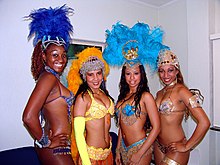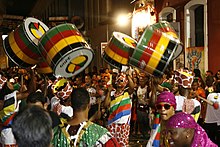User:Divrath/sandbox
Samba is a lively, rhythmical dance of Afro-Brazilian origin in 2/4(2 by 4) time danced to Samba music whose origins include the Maxixe.

Samba is a dance form that was created by African people in Brazil who brought much of their music and dance culture into Latin America with them upon arrival into many Latin American countries. Samba music is very similar to and has been influenced by many Angolan music genres. It has also been influenced by many other Latin American music genres and dances. The Samba originally acted as a general term that described several Latin duet dances with origins from the Congo and Angola. Presently, the Samba is the most prevalent dance form in Brazil, and reaches the height of its importance during the festival of Carnaval.[1] There is actually a set of dances, rather than a single dance, that define the Samba dancing scene in Brazil; however, no one dance can be claimed with certainty as the "original" Samba style.
A major stream of the Samba dance besides the Brazilian Samba dancing styles is ballroom Samba, which differs significantly.
Etymology of Samba
[edit]There are many theories regarding the origin of the word Samba.
Samba music contains many influences from Angolan music genres; it is thought that the word Samba was adopted into Brazilian culture during the early nineteenth century from the Angolan word Semba.[2]
One of the first places where the word Samba has been used is in Pernambuco magazine's O Carapuceiro, which was published in February of 1838. Father Miguel Lopes Gama of Sacramento wrote an article arguing against what he called "the samba d'almocreve", which was a type of dance drama popular with black people of that time. [3]
According to Hiram Araújo da Costa, over the centuries, the festival of dances of slaves in Bahia were called samba.[3]
During the mid-19th century, the word samba referred to several different types of music made by African slaves.[4] The Samba further developed specific characteristics in each Brazilian state, not only due to the diversity of various tribes for slaves, but also because of the distinctive cultures each region embodied. Some of these popular dances were known as Baião, Bochinche, Candombe (Candomblé), Catêrêtê, Caxambú, Choradinho, Côco-inchádo, Cocumbí, Córta-jáca, Cururú, Furrundú, Jongo, Lundú, Maracatú, Maxíxe, Quimbête, São-Gonçalo, Saramba; not to mention the many varieties of the Portuguese Fandango, and the Indio dance Puracé.[5]
Samba Pagode
[edit]Samba Pagode is a Samba partner dance that resembles the Samba de Gafieira but has less acrobatic movements and tends to be more intimate. The literal meaning of the Portuguese word "pagode" translates to "fun" or "merrymaking".[4] The word is also utilized to refer to an informal gathering of samba dancers along with their accompanying music.

A key feature of Samba Pagode is its rhythmic texture created with a variety of beats. It became a dance style after the appearance of the Pagode style of music, which originated in the Brazilian city of São Paulo. The pagode style utilizes three specific percussion instruments: the tanta, the repique-de-mao, and the pandeiro.[4] All three instruments are played by hand, which lends to creating a softer, more intimate sound than the batucada Samba performed by many Samba schools in Brazil.[4] Pagode-like events have dated back to the late nineteenth and early twentieth centuries, with the emergence of urban Samba in Rio de Janeiro.
Samba-reggae
[edit]Samba-reggae is a mix of reggae beats created by Samba drums. It is found in popular songs by the artist Daniela Mercury, who introduced the rhythm to the world with songs like "Sol da Liberdade" "O Reggae E O Mar" and "Perola Negra". Samba Reggae is a popular samba style in Bahia, with many followers in various parts of Brazil.

Samba-reggae has birthed a style of African-influenced dance which has been obtained from the styles of Afro-Brazilian and candomble dance. Within social settings, samba-reggae dances are often performed in a follow-the-leader manner, with a small number of advanced dancers initiating steps in a line in front of the crowd, and then the whole crowd subsequently following along.[6] The percussionists of samba-reggae often dance while playing their drums as well. The third- and fourth drummers, known as surdos perform short choreographies, utilizing mallets to emphasize sharp arm movements. The fundos (the first and second surdos at the lead) often times take center stage to showcase elaborate, deft mallet lifts and throws, and also toss their drums high overhead.[7]
Samba-rock
[edit]
Samba rock is a playful form of the samba that originates from São Paulo. It is a form of Latin nightclub dance.
One of Samba-rock's first dance instructors, Mestre Ataliba, describes the essence of the dance style. "Dance wise, samba rock is about relaxation and concentration, all at once... It blends the African 'ginga' (body flow from Capoeira), which is present at the feet and the hips, and the European reference of the ballroom etiquette. We can dance it to the sound of Rita Pavone, samba pagode, reggae, R&B. It really embraces every music culture".[8]
 | This is a user sandbox of Divrath. You can use it for testing or practicing edits. This is not the sandbox where you should draft your assigned article for a dashboard.wikiedu.org course. To find the right sandbox for your assignment, visit your Dashboard course page and follow the Sandbox Draft link for your assigned article in the My Articles section. |
- ^ Cox, James L. (2000-04). "Kariamu Weish Asante,African Dance: An Artistic, Historical and Philosophical InquiryAfrican Dance: An Artistic, Historical and Philosophical Inquiry254 pp., with illustrations Kariamu Welsh Asante (ed.) African World Press, Inc: Trenton, New Jersey, 1996 $16.95, £11.99 (p/b) (Distributed in Europe by Turnaround)". Dance Research. 18 (1): 108–111. doi:10.3366/1291016. ISSN 0264-2875.
{{cite journal}}: Check date values in:|date=(help) - ^ Mariani, Myriam (1994). African influences in Brazilian Dance. Africa World Press, Inc. ISBN 0865431965.
- ^ a b McCann, B. (2007-12-01). "Blues and Samba: Another Side of Bossa Nova History". Luso-Brazilian Review. 44 (2): 21–49. doi:10.1353/lbr.2008.0005. ISSN 0024-7413.
- ^ a b c d Galinsky, Philip (1996). "Co-option, Cultural Resistance, and Afro-Brazilian Identity: A History of the "Pagode" Samba Movement in Rio de Janeiro". Latin American Music Review / Revista de Música Latinoamericana. 17 (2): 120. doi:10.2307/780347. ISSN 0163-0350.
- ^ 1812-1894., Beaurepaire, Henrique de Beaurepaire Rohan visconde de, (1889). Diccionario de vocabulos brazileiros. Imprensa Nacional. OCLC 221623539.
{{cite book}}:|last=has numeric name (help)CS1 maint: extra punctuation (link) CS1 maint: multiple names: authors list (link) - ^ "Performances". Axé Capoeira Chicago. Retrieved 2018-11-27.
- ^ Béhague, Gerard (2006). "Rap, Reggae, Rock, or Samba: The Local and the Global in Brazilian Popular Music (1985-95)". Latin American Music Review / Revista de Música Latinoamericana. 27 (1): 79–90.
- ^ "Tracing The Evolution Of Samba-Rock In São Paulo". Vinyl Me Please. 2018-09-11. Retrieved 2018-11-27.
